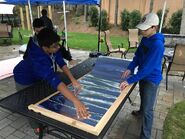Tom Sponheim (talk | contribs) Tag: sourceedit |
Tom Sponheim (talk | contribs) mNo edit summary |
||
| (19 intermediate revisions by 4 users not shown) | |||
| Line 1: | Line 1: | ||
{{GoogleTranslateLinks}} |
{{GoogleTranslateLinks}} |
||
| − | {{Updated| |
+ | {{Updated|2|4|20}} |
| − | [[File:Haines_Solar_Cooker,_11-17-14.png|thumb|400px|The Haines Solar Cooker]] |
+ | [[File:Haines_Solar_Cooker,_11-17-14.png|thumb|400px|The Haines Solar Cooker.]] |
| + | [[File:Cocineros_Solares_January_2020_San_Miguel_Del_Valle,_Mexico.jpg|thumb|400px|{{NewFeb20}}Haines 1 cookers displayed after a workshop near Oaxaca, [[Mexico]] in 2020]] |
||
| − | "It boils water 50% faster than any other panel or box cooker," says [[Roger Haines]] of San Diego, {{state|California}}, [[USA]], based on his side-by-side tests comparing the Haines Solar Cooker with seven other commercial panel and box cookers. According to Roger, the |
+ | "It boils water 50% faster than any other panel or box cooker," says [[Roger Haines]] of San Diego, {{state|California}}, [[USA]], based on his side-by-side tests comparing the Haines Solar Cooker with seven other commercial panel and box cookers. According to Roger, the Haines Solar Cooker heated a liter of water to boiling in about an hour, while the next-best cooker took an hour and a half, and some cookers did not reach the boiling point at all. Successive tests were conducted in Del Mar, California, on several calm days in August 2015 with ambient air temperatures around {{Degree|25}}. For the full report, go to http://www.hainessolarcookers.com/test-results. |
| − | These solar cookers are available in the |
+ | These solar cookers are available in the [[USA]] through [http://www.hainessolarcookers.com Haines Solar Cookers], but outside the U.S., the design is "open source." In 2013, Roger's Rotary Club distributed 291 solar cookers in Nairobi, [[Kenya]], and found that, on average, solar cooking saved USD 9.00 per month in firewood costs. An additional Rotary project saw a partnership with Washington D.C.-based Solar Household Energy to facilitate the manufacture and sale of Haines Solar Cookers in stores in Nairobi by the Kenya-based NGO, [[NAREWAMA]]. |
| + | |||
| ⚫ | The Haines reflector is made of MPET (metalized polyester) film bonded to {{CM|0.3}} of IXPE (cross-linked polyester) foam, with a white PET film backing. According to the manufacturer, the reflective polyester will not oxidize, cannot be scratched off, and has a high melting point. Importantly, the new material is reportedly easy to recycle and is environmentally safe through the whole production and recycling process without pollution. In the U.S., this material is used to make high-end auto windshield sunshades that last more than 10 years. |
||
| ⚫ | The Haines reflector is made of MPET (metalized polyester) film bonded to |
||
===The reflector=== |
===The reflector=== |
||
| − | The reflector is a 60 |
+ | The reflector is a {{CM|60}} x {{CM|120}} rectangle of reflective material, with three cuts. Overlapping the cuts as shown produces a flat bottom and a parabolic shape, secured with a single brass fastener inserted through grommet holes. According to the manufacturer, the cooker sits solidly on the ground and withstands strong winds when secured by a string passed through holes in the bottom of the cooker. When the sun is low, the front of the cooker can be tilted down to catch more sun. |
===The cooking sleeve=== |
===The cooking sleeve=== |
||
| − | [[File:2014_Cooking_sleeve.jpg|thumb|250px|Cooking sleeve for the Haines Solar Cooker]] |
+ | [[File:2014_Cooking_sleeve.jpg|thumb|250px|Cooking sleeve for the Haines Solar Cooker.]] |
| − | + | Roger Haines designed a permanent "cooking sleeve" to insulate the cooking pot while keeping the lid accessible during cooking. The sleeve is a {{Inch|6}} x {{Inch|48}} rectangle of UV-resistant 0.5 mm clear polycarbonate film, rolled into an adjustable cylinder that fits any round cooking pot with a top rim and no handles. The top rim of the pot rests on the top rim of the cooking sleeve, elevating the pot so that the sun's rays can be reflected onto the bottom of the pot. Roger has found that a glass lid works best because it retains more heat. |
|
===The cover=== |
===The cover=== |
||
| − | [[File:Haines_I_Windscreen_alone.jpg|thumb|250px|Haines Windscreen]] |
+ | [[File:Haines_I_Windscreen_alone.jpg|thumb|250px|Haines Windscreen.]] |
| − | A circular cover keeps the reflector rigid in the wind and creates "oven-like" conditions around the cooking pot. |
+ | A circular cover keeps the reflector rigid in the wind and creates "oven-like" conditions around the cooking pot. The cover is made from a {{CM|60}} diameter circle of 0.5 mm UV-resistant polycarbonate film. For increased rigidity, a radius cut is overlapped {{CM|7}} to form a flat cone like a sun hat. The overlap is secured by a string connecting grommet holes in the cover and the reflector. To access the [[pot]], the cover can be moved to the side, as shown in upper left of the photo. |
===Shipping and storage=== |
===Shipping and storage=== |
||
| Line 24: | Line 26: | ||
=={{HeadingNews}}== |
=={{HeadingNews}}== |
||
| + | *{{NewJul19}}'''June 2019:''' [[Roger Haines]] conducted cooking tests with the Haines 1 and 2 versus the [[CooKit]] and [[HotPot]] showing that the former two cookers heated water much faster than the latter two during a Southern California summer. [[Media:Cooking_tests_with_the_Haines_1_and_2_versus_the_CooKit_and_Hot_Pot_-_June_2019.pdf|More information...]] |
||
| − | *{{NewDec16}}'''October 2016: Eagle Scout organizes a build of thirty solar cookers for Haiti''' - For his Eagle Scout project, Russell Desrosier of Fairfax, {{State|Virginia}}, [[USA]], arranged for his Boy Scout troop to build thirty [[Haines Solar Cooker]]s for [[Haiti]]. In the group photo, Russell |
+ | *{{NewDec16}}'''October 2016: Eagle Scout organizes a build of thirty solar cookers for Haiti''' - For his Eagle Scout project, Russell Desrosier of Fairfax, {{State|Virginia}}, [[USA]], arranged for his Boy Scout troop to build thirty [[Haines Solar Cooker]]s for [[Haiti]]. In the group photo, Russell is the one in the funny hat made from a circular cover. Russell plans to deliver the cookers in January 2017 to recipients in Haiti as part of a project organized by WeCareToShare, Chantal, a medical-dental relief team that has been working in Chantal, Haiti, since the 2010 earthquake. Chantal is a rural rice-farming village approximately 250 km from Port Au Prince on the Tiburon Peninsula. The team obtained a grant from Rotary District 7610 to improve a kitchen at one of the Chantal schools that serves almost 900 students in grades K - 12. The group has been consulting with solar cooking experts [[Mary Buchenic]] and [[Sharon Cousins]] and plans an intensive one-week workshop on solar cooking for the village. They'll be teaching the school's cooks, as well as adults from the village, how to solar cook. |
:<gallery> |
:<gallery> |
||
File:Des6post.jpg |
File:Des6post.jpg |
||
| Line 38: | Line 41: | ||
*{{NewMay16}}'''May 2016:''' Haines cookers test successfully at [[Gaga Refugee Camp]]. |
*{{NewMay16}}'''May 2016:''' Haines cookers test successfully at [[Gaga Refugee Camp]]. |
||
[[File:Wapi Chuck and Marge 2016.JPG|right|250px]] |
[[File:Wapi Chuck and Marge 2016.JPG|right|250px]] |
||
| − | *{{NewFeb16}}'''February, 2016''': On February 13, 2016, about 40 young people from San Diego |
+ | *{{NewFeb16}}'''February, 2016''': On February 13, 2016, about 40 young people from San Diego Rotary Clubs spent their Saturday at the University of California, San Diego, making almost 1,000 Water Pasteurization Indicators (WAPIs) for solar cooker projects in East Africa. These simple, reusable devices use a short plastic tube with wax that melts at pasteurization temperature — about {{Degree|66}} — to show when water is safe to drink. Because they eliminate the need to heat water to boiling, they permit twice as much water to be pasteurized in a day. Roger Haines made a presentation about Rotary's Solar Cooker Project in Gulu, Uganda. Five hundred of the WAPIs will be given away with the Haines Solar Cookers that will be distributed in March – April 2016. |
[[File:Haines_Cooker_used_by_Camily_Wedende_February_2016.jpg|right|250px]] |
[[File:Haines_Cooker_used_by_Camily_Wedende_February_2016.jpg|right|250px]] |
||
| − | *{{NewFeb16}}'''February 2016:''' On February 1, 2016, [[Camily Wedende]] of [[Sun Cookers International]] in Eldoret, [[Kenya]], put on a "train the trainer" program in preparation for the Gulu, Uganda, Rotary Club's distribution of 500 Haines Solar Cookers in Northern [[Uganda]]. Geoffrey Okello of the [[Rotary Club of Gulu]] reported that the group benefited greatly from Mr. Wedende's solar cooking knowledge and experience and above all learned how to cook African [[:Category:Foods|staple foods]] in a solar cooker. To cook ''Posho'' ([[ugali]]), the flour needs to be mixed with cold water and covered, instead of the normal way of first boiling the water before adding the flour, and no stirring is required. Sweet potatoes and cassava need to be cut into small pieces, eggs have to be placed directly on the solar cooker instead of the normal way of boiling in water. The group made and drank tea before cooking the following food items for lunch: |
+ | *{{NewFeb16}}'''February 2016:''' On February 1, 2016, [[Camily Wedende]] of [[Sun Cookers International]] in Eldoret, [[Kenya]], put on a "train the trainer" program in preparation for the Gulu, Uganda, Rotary Club's distribution of 500 Haines Solar Cookers in Northern [[Uganda]]. Geoffrey Okello of the [[Rotary Club of Gulu]] reported that the group benefited greatly from Mr. Wedende's solar cooking knowledge and experience and above all learned how to cook African [[:Category:Foods|staple foods]] in a solar cooker. To cook ''Posho'' ([[ugali]]), the flour needs to be mixed with cold water and covered, instead of the normal way of first boiling the water before adding the flour, and no stirring is required. Sweet potatoes and cassava need to be cut into small pieces, eggs have to be placed directly on the solar cooker instead of the normal way of boiling in water. The group made and drank tea before cooking the following food items for lunch: sweet potatoes, [[rice]], green vegetables, eggs, and ''posho''. |
| − | [[File:Amayo AVF training group photo.jpg|thumb|250px|[[John Amayo]] demonstrating Haines Solar Cookers in |
+ | [[File:Amayo AVF training group photo.jpg|thumb|250px|[[John Amayo]] demonstrating Haines Solar Cookers in Kisumu, Kenya.]] |
*[[John Amayo]] demonstrates and sells Haines Solar Cookers in Kisumu, Kenya. |
*[[John Amayo]] demonstrates and sells Haines Solar Cookers in Kisumu, Kenya. |
||
| − | *'''November 2014: |
+ | *'''November 2014: Solar Cooker Business Opportunity''' - Roger Haines reports that a prominent Nairobi, [[Kenya]], building supply company is now selling materials to make "open source" Haines Solar Cookers for USD 15.00 per cooker in wholesale quantities of 50 or more. Contact Nishal Sodha at Global Hardware, Ltd., a subsidiary of Elgon-Kenya (http://www.globalhardware.co.ke), telephone: +254 20 2399998, +254 20 2399998/7; cell: +254 786 456 225; Email: nishal@globalhardware.co.ke. Finished cookers are available from [[Faustine Odaba]], director of the Nairobi NGO, [[NAREWAMA]]. Telephone: +254722828317; Email: [mailto:faustine_odaba@yahoo.com faustine_odaba@yahoo.com]. |
==How to Make a Haines Solar Cooker== |
==How to Make a Haines Solar Cooker== |
||
===Making the reflector=== |
===Making the reflector=== |
||
| − | [[File:Haines_II_New_Template_001.jpg|thumb|300px|Template for version II]] |
+ | [[File:Haines_II_New_Template_001.jpg|thumb|300px|Template for version II.]] |
| − | [[File:Haines_Foam_Insualtion_Cooker_folded_open,_2-10-14.jpg|thumb|300px|Partially |
+ | [[File:Haines_Foam_Insualtion_Cooker_folded_open,_2-10-14.jpg|thumb|300px|Partially assembled Haines reflector.]] |
| − | # Make a template from a 60 |
+ | # Make a template from a {{CM|60}} x {{CM|120}} rectangle of thin material using a saw to make three cuts; drill six small holes "B" and "C" as shown. |
# Lay a large piece of plywood on a table. |
# Lay a large piece of plywood on a table. |
||
| − | # To "guide" the material, attach a length of 2 |
+ | # To "guide" the material, attach a length of {{CM|2}} square wood to the plywood, exactly {{CM|60}} from and parallel to the bottom edge, and another piece {{CM|124}} from and parallel to the right edge of the plywood [{{CM|4}} longer than the {{CM|120}} template]. |
| − | # Unroll 120 |
+ | # Unroll {{CM|120}} of material onto the lower right-hand corner of the plywood and line it up with the "guides." |
| − | # Lay the template on top of the reflective material and line it up with the "guides." Use a utility knife ("box cutter") along the right side of the template to cut 120 |
+ | # Lay the template on top of the reflective material and line it up with the "guides." Use a utility knife ("box cutter") along the right side of the template to cut {{CM|120}} of material off the roll and to make the three cuts along the bottom edge. (This will cut grooves into the plywood, but that is OK.) |
| − | # Use a black pen to |
+ | # Use a black pen to mark the seven holes on the reflective material. Lift the template. Lay a small stiff template on the "fold" lines and FOLD the material, allowing it to unfold. |
| − | # Move the material to another table |
+ | # Move the material to another table and use a grommet tool to install grommets at the seven marked places. |
| − | # Put a brass connector through the hole in short middle section, pointing up, and spread the two sides apart. |
+ | # Put a brass connector through the hole in the short middle section, pointing up, and spread the two sides apart. |
===Making the cover=== |
===Making the cover=== |
||
[[File:Haines_Solar_Copoker,_windscreen_cutting_tool,_11-17-14.png|thumb|150px|Knife blade attached to windscreen cutting tool.]] |
[[File:Haines_Solar_Copoker,_windscreen_cutting_tool,_11-17-14.png|thumb|150px|Knife blade attached to windscreen cutting tool.]] |
||
[[File:Haines_Solar_Cooker,_cutting_the_windscreen,_11-17-14.png|thumb|150px|Cutting the circular windscreen.]] |
[[File:Haines_Solar_Cooker,_cutting_the_windscreen,_11-17-14.png|thumb|150px|Cutting the circular windscreen.]] |
||
| − | # Cut a flat square or circle of plywood or fiberboard at least 65 |
+ | # Cut a flat square or circle of plywood or fiberboard at least {{CM|65}} on a side. |
| − | # Put a nail through the exact center, so that the nail protrudes at least 3 |
+ | # Put a nail through the exact center, so that the nail protrudes at least {{CM|3}}. |
| − | # Take a 3 to 5 |
+ | # Take a {{CM|3}} to {{CM|5}} square of wood, about {{CM|35}} long. Screw a box cutter blade to the end as shown. '''WARNING:''' Put tape over the left part of the blade for safety. |
| − | # Drill a hole slightly bigger than the nail |
+ | # Drill a hole slightly bigger than the nail, approximately {{CM|29.75}} from the blade. |
| − | # Take a sheet of 60 |
+ | # Take a sheet of {{CM|60}} x {{CM|120}} clear polycarbonate film. Treat as two {{CM|60}} squares and drill a hole at the center of each {{CM|60}} square, the same size as the nail. |
# Lay the polycarbonate sheet on top of the flat plywood, with the nail through one of the drilled holes. |
# Lay the polycarbonate sheet on top of the flat plywood, with the nail through one of the drilled holes. |
||
| − | # Put the piece of wood with the cutting blade on top of the |
+ | # Put the piece of wood with the cutting blade on top of the polycarbonate sheet, with the nail through the hole in the wood and the cutting blade down. |
# Press down on the wood so that the blade cuts into the polycarbonate, and rotate 360 degrees to cut a clean circle. |
# Press down on the wood so that the blade cuts into the polycarbonate, and rotate 360 degrees to cut a clean circle. |
||
# Use scissors to make a "radius" cut from the edge to the center. |
# Use scissors to make a "radius" cut from the edge to the center. |
||
| − | # NOTE: |
+ | # NOTE: The sheets come with protective film on both sides — REMOVE this film now. |
| − | # Use the grommet tool to attach a grommet 1.5 |
+ | # Use the grommet tool to attach a grommet {{CM|1.5}} from the radius cut, a second grommet {{CM|6}} from the other side of the radius cut, and a third grommet 180 degrees opposite, on the other side of the circle. |
| − | # Tie 42 |
+ | # Tie {{CM|42}} lengths of braided string to the two opposite holes. |
===Making the cooking sleeve=== |
===Making the cooking sleeve=== |
||
| − | The cooking sleeves come ready-made as 16 |
+ | The cooking sleeves come ready-made as {{CM|16}} x {{CM|120}} sheets. However, the protective film on both sides must be removed. |
| + | |||
| + | ==Audio and video== |
||
| + | *{{NewJan20}}'''August 2019:''' |
||
| + | ::[[File:Cómo armar un Horno Solar Haines I. Tutorial|thumb|none|400 px|Bibiana Hernández, de la comunidad de San Miguel del Valle, Tlacolula, Oax, tiene 2 años usando su horno solar Haines y promoviéndolo en sus comunidades como parte del proyecto piloto impulsado por Solar Household Energy, Inc. En este tutorial, ella nos explica como se arma un horno solar para poder cocinar los alimentos con energía solar.]] |
||
| + | |||
| + | *{{NewJan20}}'''June 2014:''' |
||
| + | ::[[File:Prueba con frijoles en un Haines I|none|400 px]] |
||
==See also== |
==See also== |
||
*[[Roger Haines]] |
*[[Roger Haines]] |
||
| + | *[[Haines 2.0 Solar Cooker]] |
||
| + | *{{NewJun17}}[[Haines/Copenhagen Solar Cooker]] |
||
*[[Sun Cookers International]] |
*[[Sun Cookers International]] |
||
*[[Windshield Shade Solar Cooker]] |
*[[Windshield Shade Solar Cooker]] |
||
| Line 95: | Line 107: | ||
[[Category:Solar cooker plans]] |
[[Category:Solar cooker plans]] |
||
[[Category:Solar panel cooker plans]] |
[[Category:Solar panel cooker plans]] |
||
| − | [[Category:Kenya]] |
||
| − | [[Category:Nairobi Province]] |
||
| − | [[Category:Manufacturers and vendors]] |
||
| − | [[Category:Verified active 2016]] |
||
Revision as of 23:45, 24 February 2020
|
Last edited: 4 February 2020
|
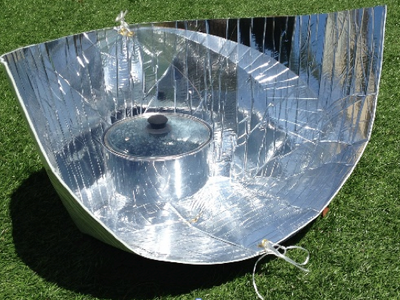
The Haines Solar Cooker.
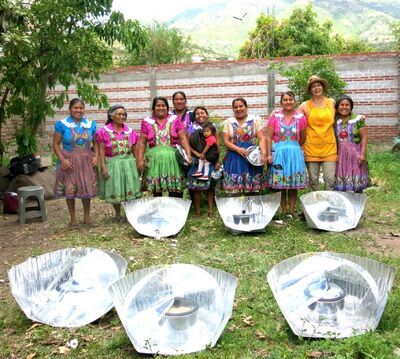
Haines 1 cookers displayed after a workshop near Oaxaca, Mexico in 2020
"It boils water 50% faster than any other panel or box cooker," says Roger Haines of San Diego, California, USA, based on his side-by-side tests comparing the Haines Solar Cooker with seven other commercial panel and box cookers. According to Roger, the Haines Solar Cooker heated a liter of water to boiling in about an hour, while the next-best cooker took an hour and a half, and some cookers did not reach the boiling point at all. Successive tests were conducted in Del Mar, California, on several calm days in August 2015 with ambient air temperatures around 25 °C (77 °F). For the full report, go to http://www.hainessolarcookers.com/test-results.
These solar cookers are available in the USA through Haines Solar Cookers, but outside the U.S., the design is "open source." In 2013, Roger's Rotary Club distributed 291 solar cookers in Nairobi, Kenya, and found that, on average, solar cooking saved USD 9.00 per month in firewood costs. An additional Rotary project saw a partnership with Washington D.C.-based Solar Household Energy to facilitate the manufacture and sale of Haines Solar Cookers in stores in Nairobi by the Kenya-based NGO, NAREWAMA.
The Haines reflector is made of MPET (metalized polyester) film bonded to 0.3 cm (0.1 in) of IXPE (cross-linked polyester) foam, with a white PET film backing. According to the manufacturer, the reflective polyester will not oxidize, cannot be scratched off, and has a high melting point. Importantly, the new material is reportedly easy to recycle and is environmentally safe through the whole production and recycling process without pollution. In the U.S., this material is used to make high-end auto windshield sunshades that last more than 10 years.
The reflector
The reflector is a 60 cm (23.6 in) x 120 cm (47.3 in) rectangle of reflective material, with three cuts. Overlapping the cuts as shown produces a flat bottom and a parabolic shape, secured with a single brass fastener inserted through grommet holes. According to the manufacturer, the cooker sits solidly on the ground and withstands strong winds when secured by a string passed through holes in the bottom of the cooker. When the sun is low, the front of the cooker can be tilted down to catch more sun.
The cooking sleeve
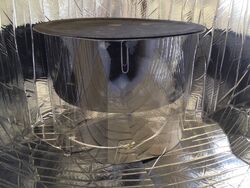
Cooking sleeve for the Haines Solar Cooker.
Roger Haines designed a permanent "cooking sleeve" to insulate the cooking pot while keeping the lid accessible during cooking. The sleeve is a 15.2 cm (6 in) x 121.8 cm (48 in) rectangle of UV-resistant 0.5 mm clear polycarbonate film, rolled into an adjustable cylinder that fits any round cooking pot with a top rim and no handles. The top rim of the pot rests on the top rim of the cooking sleeve, elevating the pot so that the sun's rays can be reflected onto the bottom of the pot. Roger has found that a glass lid works best because it retains more heat.
The cover
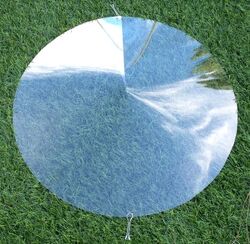
Haines Windscreen.
A circular cover keeps the reflector rigid in the wind and creates "oven-like" conditions around the cooking pot. The cover is made from a 60 cm (23.6 in) diameter circle of 0.5 mm UV-resistant polycarbonate film. For increased rigidity, a radius cut is overlapped 7 cm (2.8 in) to form a flat cone like a sun hat. The overlap is secured by a string connecting grommet holes in the cover and the reflector. To access the pot, the cover can be moved to the side, as shown in upper left of the photo.
Shipping and storage
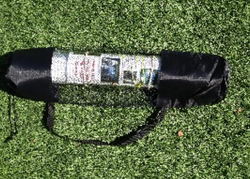
The cooker packed for storage or transport.
For shipping and storage, the cooker rolls into a cylinder 60 cm (23.6 in) long and 10 cm (3.9 in) in diameter, weighing 0.5 kg (1.1 lbs).
News
- June 2019: Roger Haines conducted cooking tests with the Haines 1 and 2 versus the CooKit and HotPot showing that the former two cookers heated water much faster than the latter two during a Southern California summer. More information...
- October 2016: Eagle Scout organizes a build of thirty solar cookers for Haiti - For his Eagle Scout project, Russell Desrosier of Fairfax, Virginia, USA, arranged for his Boy Scout troop to build thirty Haines Solar Cookers for Haiti. In the group photo, Russell is the one in the funny hat made from a circular cover. Russell plans to deliver the cookers in January 2017 to recipients in Haiti as part of a project organized by WeCareToShare, Chantal, a medical-dental relief team that has been working in Chantal, Haiti, since the 2010 earthquake. Chantal is a rural rice-farming village approximately 250 km from Port Au Prince on the Tiburon Peninsula. The team obtained a grant from Rotary District 7610 to improve a kitchen at one of the Chantal schools that serves almost 900 students in grades K - 12. The group has been consulting with solar cooking experts Mary Buchenic and Sharon Cousins and plans an intensive one-week workshop on solar cooking for the village. They'll be teaching the school's cooks, as well as adults from the village, how to solar cook.
- May 2016: Haines cookers test successfully at Gaga Refugee Camp.
- February, 2016: On February 13, 2016, about 40 young people from San Diego Rotary Clubs spent their Saturday at the University of California, San Diego, making almost 1,000 Water Pasteurization Indicators (WAPIs) for solar cooker projects in East Africa. These simple, reusable devices use a short plastic tube with wax that melts at pasteurization temperature — about 66 °C (151 °F) — to show when water is safe to drink. Because they eliminate the need to heat water to boiling, they permit twice as much water to be pasteurized in a day. Roger Haines made a presentation about Rotary's Solar Cooker Project in Gulu, Uganda. Five hundred of the WAPIs will be given away with the Haines Solar Cookers that will be distributed in March – April 2016.
- February 2016: On February 1, 2016, Camily Wedende of Sun Cookers International in Eldoret, Kenya, put on a "train the trainer" program in preparation for the Gulu, Uganda, Rotary Club's distribution of 500 Haines Solar Cookers in Northern Uganda. Geoffrey Okello of the Rotary Club of Gulu reported that the group benefited greatly from Mr. Wedende's solar cooking knowledge and experience and above all learned how to cook African staple foods in a solar cooker. To cook Posho (ugali), the flour needs to be mixed with cold water and covered, instead of the normal way of first boiling the water before adding the flour, and no stirring is required. Sweet potatoes and cassava need to be cut into small pieces, eggs have to be placed directly on the solar cooker instead of the normal way of boiling in water. The group made and drank tea before cooking the following food items for lunch: sweet potatoes, rice, green vegetables, eggs, and posho.
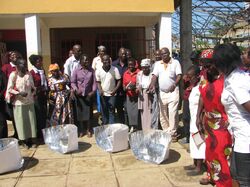
John Amayo demonstrating Haines Solar Cookers in Kisumu, Kenya.
- John Amayo demonstrates and sells Haines Solar Cookers in Kisumu, Kenya.
- November 2014: Solar Cooker Business Opportunity - Roger Haines reports that a prominent Nairobi, Kenya, building supply company is now selling materials to make "open source" Haines Solar Cookers for USD 15.00 per cooker in wholesale quantities of 50 or more. Contact Nishal Sodha at Global Hardware, Ltd., a subsidiary of Elgon-Kenya (http://www.globalhardware.co.ke), telephone: +254 20 2399998, +254 20 2399998/7; cell: +254 786 456 225; Email: nishal@globalhardware.co.ke. Finished cookers are available from Faustine Odaba, director of the Nairobi NGO, NAREWAMA. Telephone: +254722828317; Email: faustine_odaba@yahoo.com.
How to Make a Haines Solar Cooker
Making the reflector
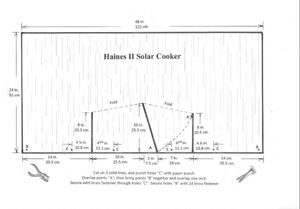
Template for version II.
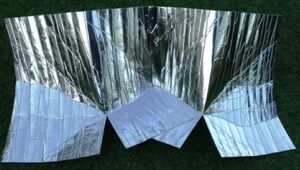
Partially assembled Haines reflector.
- Make a template from a 60 cm (23.6 in) x 120 cm (47.3 in) rectangle of thin material using a saw to make three cuts; drill six small holes "B" and "C" as shown.
- Lay a large piece of plywood on a table.
- To "guide" the material, attach a length of 2 cm (0.8 in) square wood to the plywood, exactly 60 cm (23.6 in) from and parallel to the bottom edge, and another piece 124 cm (48.9 in) from and parallel to the right edge of the plywood [4 cm (1.6 in) longer than the 120 cm (47.3 in) template].
- Unroll 120 cm (47.3 in) of material onto the lower right-hand corner of the plywood and line it up with the "guides."
- Lay the template on top of the reflective material and line it up with the "guides." Use a utility knife ("box cutter") along the right side of the template to cut 120 cm (47.3 in) of material off the roll and to make the three cuts along the bottom edge. (This will cut grooves into the plywood, but that is OK.)
- Use a black pen to mark the seven holes on the reflective material. Lift the template. Lay a small stiff template on the "fold" lines and FOLD the material, allowing it to unfold.
- Move the material to another table and use a grommet tool to install grommets at the seven marked places.
- Put a brass connector through the hole in the short middle section, pointing up, and spread the two sides apart.
Making the cover
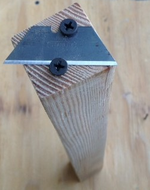
Knife blade attached to windscreen cutting tool.
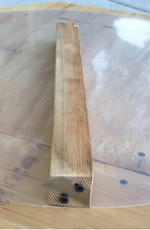
Cutting the circular windscreen.
- Cut a flat square or circle of plywood or fiberboard at least 65 cm (25.6 in) on a side.
- Put a nail through the exact center, so that the nail protrudes at least 3 cm (1.2 in).
- Take a 3 cm (1.2 in) to 5 cm (2 in) square of wood, about 35 cm (13.8 in) long. Screw a box cutter blade to the end as shown. WARNING: Put tape over the left part of the blade for safety.
- Drill a hole slightly bigger than the nail, approximately 29.75 cm (11.7 in) from the blade.
- Take a sheet of 60 cm (23.6 in) x 120 cm (47.3 in) clear polycarbonate film. Treat as two 60 cm (23.6 in) squares and drill a hole at the center of each 60 cm (23.6 in) square, the same size as the nail.
- Lay the polycarbonate sheet on top of the flat plywood, with the nail through one of the drilled holes.
- Put the piece of wood with the cutting blade on top of the polycarbonate sheet, with the nail through the hole in the wood and the cutting blade down.
- Press down on the wood so that the blade cuts into the polycarbonate, and rotate 360 degrees to cut a clean circle.
- Use scissors to make a "radius" cut from the edge to the center.
- NOTE: The sheets come with protective film on both sides — REMOVE this film now.
- Use the grommet tool to attach a grommet 1.5 cm (0.6 in) from the radius cut, a second grommet 6 cm (2.4 in) from the other side of the radius cut, and a third grommet 180 degrees opposite, on the other side of the circle.
- Tie 42 cm (16.5 in) lengths of braided string to the two opposite holes.
Making the cooking sleeve
The cooking sleeves come ready-made as 16 cm (6.3 in) x 120 cm (47.3 in) sheets. However, the protective film on both sides must be removed.
Audio and video
- August 2019:
Cómo armar un Horno Solar Haines I. Tutorial
Bibiana Hernández, de la comunidad de San Miguel del Valle, Tlacolula, Oax, tiene 2 años usando su horno solar Haines y promoviéndolo en sus comunidades como parte del proyecto piloto impulsado por Solar Household Energy, Inc. En este tutorial, ella nos explica como se arma un horno solar para poder cocinar los alimentos con energía solar.
- June 2014:
See also
- Roger Haines
- Haines 2.0 Solar Cooker
- Haines/Copenhagen Solar Cooker
- Sun Cookers International
- Windshield Shade Solar Cooker
- Haines Solar Cooker test results
External links
- http://www.hainessolarcookers.com
- November 2015: Test results
Contact
- See Roger Haines.Roger Haines


